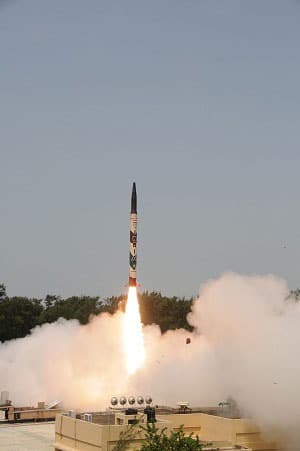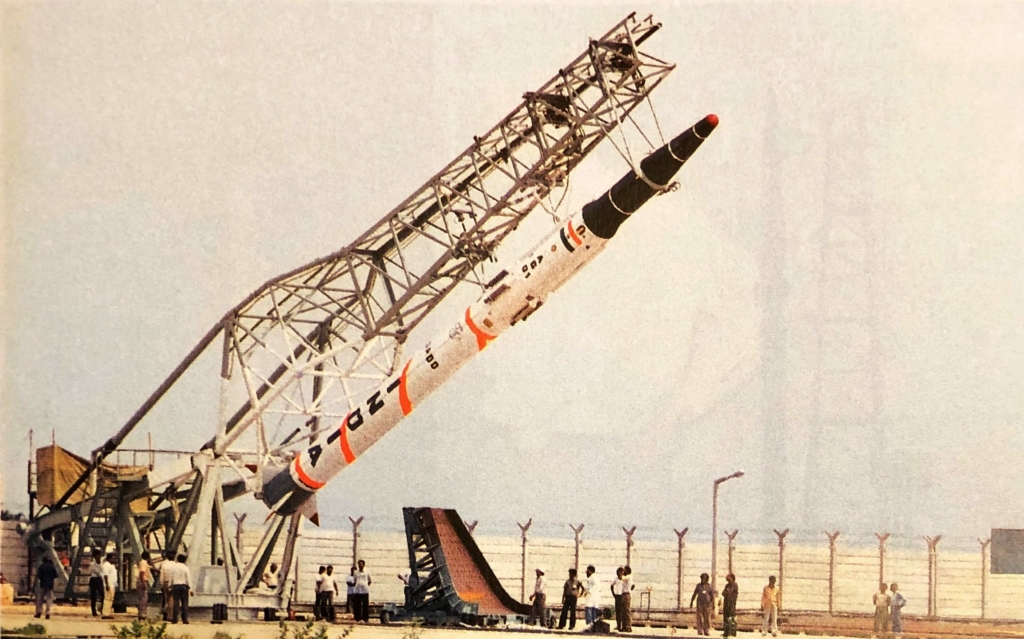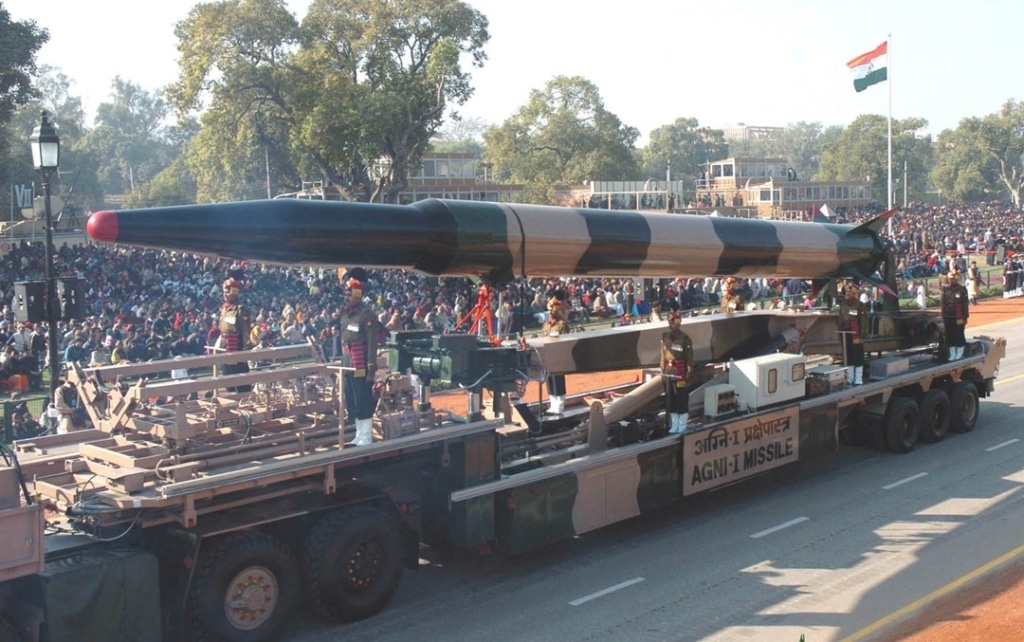The Agni-I is an Indian short-range ballistic missile (SRBM) with a range of 700 km. The Indian Army’s Strategic Forces Command first deployed the nuclear-capable, road-mobile missile in 2007.
Agni-I at a Glance
- Originated from
- India
- Class
- Short-range ballistic missile (SRBM)
- Possessed by
- India
- Basing
- Road/rail-mobile
- Length
- 15 m
- Diameter
- 1 m
- Launch weight
- 12,000 kg
- Payload
- 1,000 kg
- Warhead
- Conventional unitary or submunition, Nuclear: 20 or 45 kT
- Propulsion
- Single-stage, solid propellant
- Range
- 700 – 1,200 km
- Status
- Operational
- In service
- 2007

Agni-1 missile test flight. Photo: DRDO 
Agni technology demonstrator, with Prithvi second stage and ullage motors (external). Photo: DRDO 
Agni-I tractor-trailer configuration. Photo: Government of India
Agni-I Development
The Agni-I originated from India’s 1983 Integrated Guided Missile Development Program, which also developed the Prithvi, Nag, Akash, and Trishul missiles. India’s Defence Research and Development Organisation (DRDO) originally envisioned a two-stage rocket—the Agni demonstrator—for validating reentry vehicle technologies. The DRDO adapted the Agni from two existing boosters: a solid-fueled first stage from India’s SLV-3 space launch vehicle, and a modified Prithvi-I body for the missile’s upper stage.1
On May 22, 1989, India flight tested the Agni demonstrator for the first time. The test, a success, came after two cancelled launch attempts. In 1992, the DRDO tested an upgraded Agni demonstrator with a maneuvering reentry vehicle and open interstage, which eliminated the need for ullage motors between the first and second stages. DRDO conducted a third flight of the demonstrator—in its upgraded configuration—in 1994.2
After concluding reentry studies, the DRDO reconfigured the Agni demonstrator as a single-stage ballistic missile: the Agni-I. Agni-I development began in 1999 and the missile underwent its first test on January 25, 2002. While the missile’s reentry vehicle reportedly failed to separate, a second test on January 9, 2003 was successful. The Indian Army approved the Agni-I for full-rate production in August 2004 and accepted it into service in 2007.3
India’s Strategic Forces Command has regularly tested the Agni-I since its initial deployment. The missile underwent successful test launches in 2015, 2016, and 2018.4
Agni-I Specifications
The Agni-I is 15 m long, 1 m in diameter, and has a launch weight of 12,000 kg. It has a range of 700 km with an estimated payload of 1,000 kg, which allows it to carry nuclear warheads.5 With reduced payloads, the Agni-I may be capable of ranging up to 1,200 km, a distance which encompasses all of Pakistan.
The Agni-I employs a 1 m-diameter solid-propellant booster modified from the Indian Space Research Organisation’s (ISRO) SLV-3. Unlike the SLV-3, the motor employs HTPB composite propellant and produces roughly 48,000 kg of thrust. The missile employs a strapdown inertial guidance system and uses thrust vectoring and control surfaces on its wingtips to maneuver.6
The Agni-I is designed to be launched from rail-based platforms or road-mobile transporter erector launchers (TELs). The TEL, designated “Mark III” by the DRDO, is a tractor-trailer system, employing a separate prime mover and trailer with the missile and launch arm.7
Footnotes
- Defence Research and Development Organisation, IGMDP: Integrated Guided Missile Development Program, (New Delhi: India Department of Defence, 2008).
- DRDO 2008, pp. 114 – 115.
- Pravin Sawhney, “Countdown: Ballistic Missiles,” Force India, April 4, 2019, http://forceindia.net/countdown-ballistic-missiles/; Duncan Lennox, “Agni 1/2/3/4/5.” in Jane’s Strategic Weapon Systems (Offensive Weapons). August 13, 2011; Sai Biswanath Tripathy, “India’s Missile Programme and Odisha: A Study,” Odisha Review, January 2015, http://magazines.odisha.gov.in/Orissareview/2015/Jan/engpdf/26-31.pdf; Hans M. Kristensen and Robert S. Norris, “Indian nuclear forces, 2015,” Bulletin of the Atomic Scientists Nuclear notebook, Vol. 71 issue 5 (2015) 79.
- “India test-fires nuclear-capable Agni-I ballistic missile,” The Economic Times, March 14, 2016, http://economictimes.indiatimes.com/news/defence/india-test-fires-nuclear-capable-agni-i-ballistic-missile/articleshow/51390769.cms; “India Successfully Test-Fires Short Range Nuclear Capable Ballistic Missile Agni-I,” NDTV, February 6, 2018, https://www.ndtv.com/india-news/india-successfully-test-fires-short-range-nuclear-capable-ballistic-missile-agni-i-1809163.
- Sawhney 2019.
- Rajaram Nagappa, Evolution of Solid Propellant Rockets in India, (New Delhi: Defence Research and Development Organisation, 2013), ISBN: 978-81-86514-51-1.
- “Ground Support System for Missile Programme,” Defence Research and Development Organisation, https://www.drdo.gov.in/ground-support-system-missile-programme.